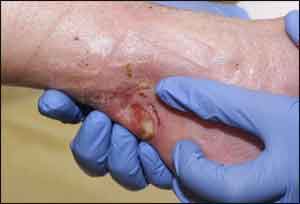- Home
- Editorial
- News
- Practice Guidelines
- Anesthesiology Guidelines
- Cancer Guidelines
- Cardiac Sciences Guidelines
- Critical Care Guidelines
- Dentistry Guidelines
- Dermatology Guidelines
- Diabetes and Endo Guidelines
- Diagnostics Guidelines
- ENT Guidelines
- Featured Practice Guidelines
- Gastroenterology Guidelines
- Geriatrics Guidelines
- Medicine Guidelines
- Nephrology Guidelines
- Neurosciences Guidelines
- Obs and Gynae Guidelines
- Ophthalmology Guidelines
- Orthopaedics Guidelines
- Paediatrics Guidelines
- Psychiatry Guidelines
- Pulmonology Guidelines
- Radiology Guidelines
- Surgery Guidelines
- Urology Guidelines
New Technology developed for faster healing of chronic wounds

Chronic wounds comprise a growing clinical problem that represents >3% of the healthcare budget in industrialized countries. Drug development is hampered by the proteolytic nature of the wounds, which greatly limits drug bioavailability. A new technology that circumvents this by on-site production and reduced chemokine degradation has been developed by Researchers at Uppsala University for faster healing of wounds.Their findings have been published in journal PNAS.The new way of accelerating wound healing involves the use of lactic acid bacteria as vectors to produce and deliver a human chemokine on site in wounds.
"We have developed a drug candidate, a next-generation biologic medical product, and are now publishing the fantastic results from the preclinical part where wound healing was strongly accelerated in mice," says Mia Phillipson, professor at the Department of Medical Cell Biology, Division of Integrative Physiology, Uppsala University.
Development of drugs accelerating wound healing is limited by the proteolytic nature of wounds. The new technology overcomes this by on-site chemokine production and reduced degradation, which together ensure prolonged chemokine bioavailability that instructed local immune cells and enhanced wound healing.
"The chemokine, CXCL12, is endogenously upregulated in injured tissue and by increasing the levels further, more immune cells are recruited and are more specialised to heal the wound, which accelerates the whole process," says Professor Phillipson.
For more details click on the link: https://doi.org/10.1073/pnas.1716580115

Disclaimer: This site is primarily intended for healthcare professionals. Any content/information on this website does not replace the advice of medical and/or health professionals and should not be construed as medical/diagnostic advice/endorsement or prescription. Use of this site is subject to our terms of use, privacy policy, advertisement policy. © 2020 Minerva Medical Treatment Pvt Ltd